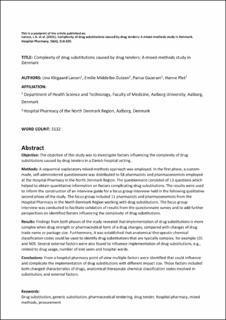| dc.description.abstract | Objective: The objective of this study was to investigate factors influencing the complexity of drug substitutions caused by drug tenders in a Danish hospital setting. Methods: A sequential explanatory mixed-methods approach was employed. In the first phase, a custom-made, self-administered questionnaire was distributed to 58 pharmacists and pharmaconomists employed at the Hospital Pharmacy in the North Denmark Region. The questionnaire consisted of 13 questions, which helped to obtain quantitative information on factors complicating drug substitutions. The results were used to inform the construction of an interview guide for a focus group interview held in the following qualitative second phase of the study. The focus group included 11 pharmacists and pharmaconomists from the Hospital Pharmacy in the North Denmark Region working with drug substitutions. The focus group interview was conducted to facilitate validation of results from the questionnaire survey and to add further perspectives on identified factors influencing the complexity of drug substitutions. Results: Findings from both phases of the study revealed that implementation of drug substitutions is more complex when drug strength or pharmaceutical form of a drug changes, compared with changes of drug trade name or package size. Furthermore, it was established that Anatomical Therapeutic Chemical classification codes could be used to identify drug substitutions that are typically complex, for example, L01 and N05. Several external factors were also found to influence implementation of drug substitutions, for example, related to drug usage, number of end users, and hospital wards. Conclusions: From a hospital pharmacy point of view, multiple factors were identified that could influence and complicate the implementation of drug substitutions with different impact size. Those factors included both changed characteristics of drugs, Anatomical Therapeutic Chemical classification codes involved in substitution, and external factors. | en_US |
